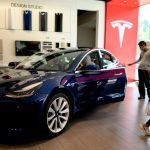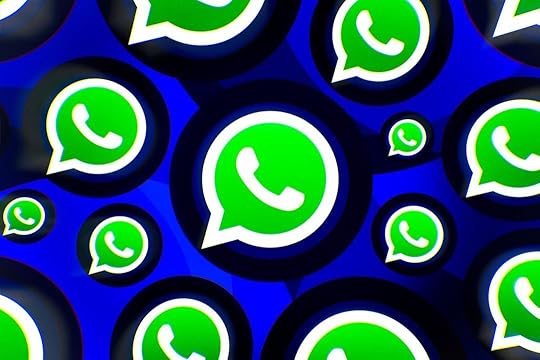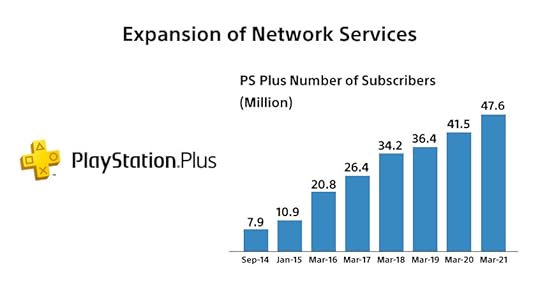Dominique Luchart's Blog, page 613
May 26, 2021
Tesla will store Chinese car data locally, following government fears about spying,

Tesla says it’s established a data center in China to store and process information produced by its vehicles locally. The announcement, made on Weibo, comes as the US carmaker faces pressure from Chinese authorities over fears its cars could be used for spying.
“Car data security is very important,” said Tesla (via Google Translate). “All data generated from the sales of vehicles in the Chinese mainland market will be stored in China.”
Reports from The Wall Street Journal and Bloomberg said Tesla’s cars have been banned from Chinese military sites, and that “military staff and employees of key state-owned companies” are prohibited from owning the vehicles. Chinese authorities were reportedly concerned that the exterior cameras on the cars could be used to collect sensitive data and send it back to the US.
Elon Musk responded by saying if this was true it would be the end of the company in China. “There’s a very strong incentive for us to be very confidential with any information,” said Musk in March. “If Tesla used cars to spy in China or anywhere, we will get shut down.”
Tesla certainly needs to keep China happy to ensure the company’s future growth. China is the world’s largest market for electric vehicles — around three to four times the size of the the US. Tesla sold 147,445 cars in China last year, according to Reuters, accounting for 30 percent of global sales.
Last month, the Chinese government published draft rules outlining its concerns with data-collection by smart vehicles. The rules state that data about roads, buildings, and terrain should not leave the country, and that customers should have to consent to data collection. Tesla expressed support for the rules through social media accounts in China.
The post Tesla will store Chinese car data locally, following government fears about spying, appeared first on NEWDAWN Blog.
Black holes, aliens, multiverse & Mars: Space TED talks you need to watch, ,
 Adventures of an asteroid hunter: Carrie Nugent, astronomer at the California Institute for Technology (Caltech)
Adventures of an asteroid hunter: Carrie Nugent, astronomer at the California Institute for Technology (Caltech)This enlightening talk centers on our oldest cosmic neighbors, asteroids, and their importance to us here on Earth. Not only can asteroids shed light on the beginnings of the solar system, they also pose a massive risk to our safety.
For example, in 2013 the Chelyabinsk asteroid entered Earth’s atmosphere over a remote area of Russia and created a shockwave that shattered windows, rocked buildings, and caused hundreds of injuries. A similar incident, on a much larger scale, is thought to be related to the fate of the dinosaurs. As a result, near-Earth asteroids are now constantly monitored in order to try and prevent another catastrophic strike on Earth.
Carrie Nugent is part of the team that uses NASA’s NEOWISE telescope, a very valuable telescope that was pulled out of retirement and reprogrammed to search the skies for asteroids and catalog them. In her talk, she reveals some breathtaking details about the size of the asteroid that wiped out the dinosaurs. She also explains what else is already being done to prevent another potentially deadly asteroid strike, and what needs to be done in future.
How to take a picture of a black hole: Katie Bouman, imaging scientist at the Massachusetts Institute of TechnologySo far, we’ve only been able to see what the inside of a black hole might look like thanks to computer graphic rendering, like those seen in the movie Interstellar. Despite Einstein‘s prediction of black holes in his theory of general relativity more than 100 years ago, we still haven’t been able to take a picture of one. But that could be about to change any day now, explains Katie Bouman in her fascinating TED Talk.
A telescope capable of capturing images of a black hole would need to be as big as Earth itself, making it impossible. However, Bouman is working as part of a team of international experts to produce a giant computational telescope (known as the Event Horizon Telescope), combining the power of telescopes around the world with imaging algorithms to fill in the gaps.
In this talk, she reveals the extraordinary process of developing these algorithms based on what experts believe a black hole should look like, using pieces of images from everyday life in order to avoid bias. Viewers will get a glimpse at how astronomers, physicists, mathematicians, and engineers have come together to solve a seemingly impossible quandary, pushing the boundaries of science.
Your kids might live on Mars. Here’s how they’ll survive: Stephen Petranek, editor-in-chief of Breakthrough Technology AlertWill we all be living on Mars in the near future? Award-winning journalist, Stephen Petranek, firmly believes it’s not a question of if, but when. His future-gazing talk looks at how we might survive on the Red Planet, and makes some pretty bold predictions about when this might actually become a reality.
All About Space
[image error]
(Image credit: Future)This article is brought to you by All About Space .
All About Space magazine takes you on an awe-inspiring journey through our solar system and beyond, from the amazing technology and spacecraft that enables humanity to venture into orbit, to the complexities of space science.
As well as reviewing the reasons why humans need to make the long journey to Mars, he discusses the physical differences between the potential Earth 2.0 and our home planet, comparing the size, temperature, atmosphere, and gravity.
While acknowledging humankind’s poor track record of successful unmanned missions to Mars, he sets out the challenges of making this trip, including surviving in such an inhospitable environment, as well as the contributions made by government agencies like NASA and private firms like SpaceX.
From how we’ll source enough oxygen and water to live on, to plans for terraforming the planet to make it more Earth-like, this is a comprehensive look at the future of Mars as a colony. It even raises the exciting possibility of a new human species evolving to adapt to the harsh conditions on the Red Planet.
I leapt from the stratosphere. Here’s how I did it: Alan Eustace, computer scientist and former Senior Vice President of Knowledge at GoogleBest known for breaking the world record for the highest-altitude free-fall jump set by Austrian daredevil Felix Baumgartner in 2012, Alan Eustace floated up into the stratosphere attached to a balloon in 2014, before plummeting back towards Earth, and parachuting to safety.
Eustace made it to over 106,000 meters (135,000 feet) in a custom-built space suit, before starting his descent and parachuting the final 3,000 meters. In this talk, he explains how the mission came to be as he pondered whether the stratosphere — one of the least accessible places on (or above) Earth — could be explored.
Eustace talks the audience through the life-preserving features of his stratospheric suit, which is made by the same company that produced the Apollo mission spacesuits.
There’s also a short video showing the preparation for the jump, as well as the death-defying feat itself. Largely a talk about the incredible engineering that makes these kind of accomplishments possible, he also talks us through the specially designed parachute technology that kept him from meeting a messy end after plummeting back to Earth.
Is our universe the only universe?: Brian Greene, professor of mathematics and physics, Columbia UniversityThis action-packed talk explores the possibility that our universe is part of a vast complex of universes called the multiverse. The animated lecture is given by theoretical physicist Brian Greene, perhaps the best-known proponent of superstring theory, the idea that tiny strands of energy vibrating in a higher dimensional space-time create every single particle and force in the universe.
Greene breaks down the complicated idea into three parts, starting with the idea that space is expanding, and how Nobel Prize-winning research in the 1990s discovered that rather than slowing down, this expansion rate is getting faster. The talk reveals how this is driven by mysterious dark energy, and explains how string theory fits into all this.
Touching on the possibility of additional dimensions in space that we have not yet detected because of their tiny scale, Greene ends on some startling revelations about what future astronomers will observe and conclude, based on the idea that other galaxies are rushing away from our own, and will eventually be too far away to see.
ET is (probably) out there — get ready: Seth Shostak of the SETI InstituteWhile we’ve yet to make contact with any other form of life beyond our own planet, Seth Shostak is so confident that we’ll find ET in the coming years, he bet everyone listening to his TED talk a cup of coffee if he’s wrong. As a senior astronomer at SETI (Search for Extraterrestrial Intelligence), Shostak has been searching for signs of intelligent life in space for some time. His riveting, and at times hilarious, account of his work highlights the growing likelihood of finding aliens in the near future.
Recent developments in equipment and missions, such as NASA’s Kepler exoplanet-hunting mission, enables better estimations of known planets that might hold alien life, with the search speeding up exponentially. Not only does he explain how the search for cosmic company is progressing, he also ponders what success could mean, and how difficult it is to predict the consequences of an alien interaction.
Focusing on the huge benefits of exploration, the talk looks at how making contact with alien civilizations more advanced than our own could help us here on Earth, while the search itself is helping to improve science literacy and encourage more children to pursue STEM subjects.
Have we reached the end of physics?: Harry Cliff, particle physicist at CERN and Science Museum Fellow of Modern ScienceParticle physicist Harry Cliff takes us on a mind-boggling journey to discuss the future of physics. As a scientist working on the Large Hadron Collider at CERN, Cliff is well placed to run through the basics of Einstein’s general theory of relativity and quantum mechanics, and how these groundbreaking ideas have completely transformed our understanding of the universe.
Over 100 years on from Einstein’s theory, physics is at another turning point, explains Cliff. Could the laws of physics prevent us from making further discoveries and stop us from ever truly understanding why there is ‘something rather than nothing’? CERN’s discovery of the Higgs Boson may have proved the existence of a cosmic energy field, but the Higgs field is still not fully understood.
What’s more, the mysteries of dark energy, string theory, and the concept of the multiverse are all compelling concepts, but Cliff questions whether we will ever be able to explain or definitively prove their existence. Are we entering a new world of science where the laws of physics have reached their limit, and we’re simply not capable of proving or disproving our theories?
How to go to space, without having to go to space: Angelo Vermeulen, crew commander for NASABelgian visual artist Angelo Vermeulen, who is also a crew commander of the NASA-funded HI-SEAS (Hawaii Space Exploration Analog and Simulation) Mars simulation, has already completed a four-month stay in the isolated dome on Hawaii’s Mauna Loa Volcano.
The idea is to prepare humans for life in deep space by investigating how crew members can successfully live together in such small and isolated places. While staying in the dome, the team also carried out a number of research projects, including a food study and missions in mockup spacesuits.
In his talk, Vermeulen also runs us through his art project called ‘Seeker’, which encourages teams around the world to come up with prototypes for long-duration mission starships. Along with other artists, Vermeulen runs isolation tests where he lives inside these art projects. He also talks about how the Atacama Desert in Chile is home to one of these projects. As the driest location on the planet, this location has also been used by NASA for training, as it’s the closest thing we have to the arid geology of Mars. What’s more, he hopes to use these insights on living in such an environment from the indigenous population and integrate these into space exploration technology in the future.
Look up for a change: Lucianne Walkowicz, stellar astronomer on NASA’s Kepler missionThe night sky provides an incredible view, but what if we’re not able to see it? In this talk, Lucianne Walkowicz speaks about how light pollution is ruining our extraordinary view of space.
While there is a tendency to believe that this loss is an inevitable result of technological progress, Walkowicz, who works on NASA’s exoplanet-hunting Kepler mission, says that this need not be the case, and that the night sky should be treated as a natural resource that must be preserved.
The intense light from urban settlements around the globe is so distinct it can be photographed from space. But, most of the energy used to light outdoor spaces is wasted, says Walkowicz, leaving plenty of room for improvement.
Walkowicz also explains how people can learn more about the night sky thanks to a range of ‘citizen science projects’. These involve organizations sharing their data online and teaching people how to interact with it so they can make contributions to research. Some projects involve asking people to help classify photos from space, while new exoplanets were discovered by participants as part of the Kepler project.
Astrophysicist and planetary scientist Sara Seager’s research led to the first discovery of an atmosphere on a planet outside our solar system. In this inspiring talk, the exoplanet expert speaks about the search for potentially habitable worlds beyond our own.
Thousands of exoplanets have been pinpointed during the last couple of decades, but that’s just the tip of the iceberg. The astonishing variety of exoplanets already discovered includes gas giants that would be far too hot to support life, in contrast with Kepler-186f, so far considered to be one of the most likely spots for discovering life. This Earth 2.0 is a so-called “Goldilocks” planet, not too hot or too cold, but just the right temperature. However, what’s really important in the search for potentially habitable exoplanets is examining their atmospheres, explains Seager.
While the Hubble Space Telescope has been used to study the atmospheres of larger exoplanets, we still don’t have the technology to study smaller planets. This intriguing talk highlights the importance of assessing the amount of gases present in these distant worlds, and how that could lead to the discovery of intelligent alien life.
The post Black holes, aliens, multiverse & Mars: Space TED talks you need to watch, , appeared first on NEWDAWN Blog.
Commercial space clean-up service could be ready in 2024, ,

Japan-headquartered space services company Astroscale, which recently launched its ELSA-d space debris removal demonstrator, might be ready to start cleaning up the mess in Earth’s orbit by 2024.
The company, which has offices in the U.K., U.S., Israel and Singapore, has signed a $3.5 million deal with would-be megaconstellation operator OneWeb to work together on advancing debris-removal technology. OneWeb currently operates over 180 satellites in a constellation meant to reach about 650 satellites, but has asked the U.S. Federal Communications Commission (FCC) to approve over 6,300 satellites in its “Phase Two” strategy. OneWeb is partially owned by the British government.
Plans of companies such as OneWeb, SpaceX and Amazon to launch constellations of thousands of satellites cause serious concerns in the global space flight community as the already cluttered orbital environment is at risk of becoming overcrowded. Satellite operators already report a growing number of situations when two satellites come close to colliding. OneWeb’s cooperation with Astroscale might help attenuate some of the concerns.
Related: All about space junk
“This partnership with OneWeb demonstrates their commitment to space sustainability and is the next step towards maturing our technologies to develop a full-service debris removal offering by 2024,” John Auburn, managing director of Astroscale U.K. and group chief commercial officer said in a statement.
The new service targets constellation operators and is called ELSA-M. The program would enable the removal of multiple retired satellites in a single mission, thus reducing cost for the client, the company said in the statement. The orbital junk collector would push each satellite into the atmosphere to burn up, then return for the next defunct piece.
“This funding will help us evolve key rendezvous and proximity operations technologies and capabilities beyond ELSA-d towards an end-of-life servicing offering for a range of constellation customers,” Jason Forshaw, Astroscale’s head of future business, Europe, said in the statement. “In parallel to this project, we’re developing our next generation docking plate (DP), which is fitted to clients before launch, and is designed to enable a servicer to grapple the client. We are encouraging constellation customers to fit DPs to future-proof their satellites in case of need for removal due to failure, or at end of life, or to provide future in-orbit servicing.”
Astroscale’s ELSA-d demonstration mission, currently in low Earth orbit, will carry out a series of rendezvous and close proximity debris capture and release manoeuvres this summer. The results of the test campaign will inform further work on the ELSA-M program, Astroscale said.
The funding is part of the European Space Agency’s (ESA) program called Sunrise, developing flexible reprogrammable communication satellites.
Follow Tereza Pultarova on Twitter @TerezaPultarova. Follow us on Twitter @Spacedotcom and on Facebook.
Join our Space Forums to keep talking space on the latest missions, night sky and more! And if you have a news tip, correction or comment, let us know at: community@space.com.
The post Commercial space clean-up service could be ready in 2024, , appeared first on NEWDAWN Blog.
Microsoft claims Edge is now ‘the best performing browser on Windows 10’, Tom Warren

 Illustration by Alex Castro / The Verge
Illustration by Alex Castro / The VergeMicrosoft is now claiming the performance crown in the desktop browser battle. The software maker has been gradually adding new features to Edge over the past year to improve performance and launch times. These additions have allowed Microsoft to claim itself the performance winner, even as Google releases Chrome 91 today.
“Microsoft Edge will be the best performing browser on Windows 10 when Microsoft Edge version 91 releases later this week,” says the Microsoft Edge team in a blog post. “So, why can we say this? It’s simple: startup boost and sleeping tabs.”
Microsoft first started rolling out its new startup boost feature in Edge back in March, with claims that it makes browser launches up to 41 percent faster. The new sleeping tabs…
The post Microsoft claims Edge is now ‘the best performing browser on Windows 10’, Tom Warren appeared first on NEWDAWN Blog.
Microsoft claims Edge is now ‘the best performing browser on Windows 10’,

Microsoft is now claiming the performance crown in the desktop browser battle. The software maker has been gradually adding new features to Edge over the past year to improve performance and launch times. These additions have allowed Microsoft to claim itself the performance winner, even as Google releases Chrome 91 today.
“Microsoft Edge will be the best performing browser on Windows 10 when Microsoft Edge version 91 releases later this week,” says the Microsoft Edge team in a blog post. “So, why can we say this? It’s simple: startup boost and sleeping tabs.”
Microsoft first started rolling out its new startup boost feature in Edge back in March, with claims that it makes browser launches up to 41 percent faster. The new sleeping tabs feature also appeared earlier this year, designed to improve browser performance. Edge now automatically releases system resources for inactive tabs, which helps new tabs run better or stop the browser from hogging memory and CPU resources in the background. Microsoft is also working on a separate performance mode for Edge that’s currently in testing.
Google hasn’t been sitting around letting Chrome eat up more RAM, either. Recent updates to Chrome have included a bigger focus on performance, with a more advanced memory allocator to reduce memory usage and increase performance. The last update to Chrome in 2020 was also all about efficiency.
Microsoft has also revealed it has now submitted 5,300 commits to the Chromium browser project, which will also benefit Chrome and other Chromium-based browsers. While sleeping tabs and startup boost are features for Edge, Microsoft has helped Google improve Chrome’s tab management, and the rivals have worked together on a variety of underlying Chromium improvements.
The post Microsoft claims Edge is now ‘the best performing browser on Windows 10’, appeared first on NEWDAWN Blog.
WhatsApp sues Indian government over new rules it says break encryption, Jon Porter

 Illustration by Alex Castro / The Verge
Illustration by Alex Castro / The VergeFacebook-owned messaging service WhatsApp is suing India’s government over new internet rules it claims are unconstitutional and will “severely undermine the privacy” of its users, The New York Times reports. The Intermediary Guidelines and Digital Media Ethics Code, which was introduced in February and comes into effect today, contains a requirement that messaging apps identify the “first originator of information” when asked. But WhatsApp, which boasts nearly 400 million users in its largest market of India, argues that doing so would require it to trace every message sent on its service, violating users’ right to privacy.
“Civil society and technical experts around the world have consistently argued that a requirement to “trace”…
The post WhatsApp sues Indian government over new rules it says break encryption, Jon Porter appeared first on NEWDAWN Blog.
WhatsApp sues Indian government over new rules it says break encryption,

Facebook-owned messaging service WhatsApp is suing India’s government over new internet rules it claims are unconstitutional and will “severely undermine the privacy” of its users, The New York Times reports. The Intermediary Guidelines and Digital Media Ethics Code, which was introduced in February and comes into effect today, contains a requirement that messaging apps identify the “first originator of information” when asked. But WhatsApp, which boasts nearly 400 million users in its largest market of India, argues that doing so would require it to trace every message sent on its service, violating users’ right to privacy.
“Civil society and technical experts around the world have consistently argued that a requirement to “trace” private messages would break end-to-end encryption and lead to real abuse,” a spokesperson for the service said in a statement. “WhatsApp is committed to protecting the privacy of people’s personal messages and we will continue to do all we can within the laws of India to do so.”
WhatsApp’s warnings about “traceability” are backed of many of the world’s biggest technology firms and digital rights groups including Mozilla, the Electronic Frontier Foundation (EFF), and the Center for Democracy and Technology. In a statement about a similar plan to mandate traceability in Brazil, the EFF said that implementing traceability “will break users’ expectations of privacy and security, and would be hard to implement to match current security and privacy standards.”
Responding to efforts by India and other countries to force it to trace messages, WhatsApp has published an FAQ on its website. It argues that this traceability requirement would force it to break the end-to-end encryption for everyone on its service, because there’s no way for it to proactively know what message a government might want to investigate ahead of time. “A government that chooses to mandate traceability is effectively mandating a new form of mass surveillance,” WhatsApp’s FAQ says.
However the Indian government argues the rules are required to track the origins of misinformation. In comments reported by Reuters, a government official argued that WhatsApp isn’t being asked to break its encryption, just to track where messages originate from.
But WhatsApp says tracing messages like this “would be ineffective and highly susceptible to abuse,” and risks punishing people for being the “originator” of content just for re-sharing information they found elsewhere. According to Reuters, WhatsApp argues that the new rules fail the tests established by a 2017 Supreme Court ruling. Namely, that privacy must be preserved except when legality, necessity, and proportionality require its infringement. WhatsApp argues that the new law lacks explicit parliamentary backing.
The lawsuit is the latest heightening of tensions between the Indian government and big tech companies. In recent months officials have ordered social media networks including Twitter, Facebook, and Instagram to remove posts critical of their handling of the pandemic. The NYT notes that social media companies have complied with many of these requests by blocking posts within the country, but keeping them visible elsewhere. While the government argues these posts could incite panic, critics say it’s using the new rules to silence detractors.
In another incident, police in India raided Twitter’s offices over a “manipulated media” label applied to a tweet from a government official.
While WhatsApp has been accused of facilitating the spread of misinformation around the world, the problem has been particularly acute in India. Since 2017, the service has been linked to a series of lynchings in the country after users on the service spread misinformation about child abductions. WhatsApp responded by placing new limits on message forwarding in an attempt to stop such accusations from going viral.
The post WhatsApp sues Indian government over new rules it says break encryption, appeared first on NEWDAWN Blog.
Sony’s AI subsidiary is developing smarter opponents and teammates for PlayStation games, James Vincent

 Photo by Vjeran Pavic / The Verge
Photo by Vjeran Pavic / The VergeIn 2019, Sony quietly established a subsidiary dedicated to researching artificial intelligence. What exactly the company plans to do with this tech has always been a bit unclear, but a recent corporate strategy meeting offers a little more information.
“Sony AI […] has begun a collaboration with PlayStation that will make game experiences even richer and more enjoyable,” say notes from a recent strategy presentation given by Sony CEO Kenichiro Yoshida. “By leveraging reinforcement learning, we are developing Game AI Agents that can be a player’s in-game opponent or collaboration partner.”
This is pretty much what you’d expect from a partnership between PlayStation and Sony’s AI team, but it’s still good to have confirmation!…
The post Sony’s AI subsidiary is developing smarter opponents and teammates for PlayStation games, James Vincent appeared first on NEWDAWN Blog.
Sony’s AI subsidiary is developing smarter opponents and teammates for PlayStation games,

In 2019, Sony quietly established a subsidiary dedicated to researching artificial intelligence. What exactly the company plans to do with this tech has always been a bit unclear, but a recent corporate strategy meeting offers a little more information.
“Sony AI […] has begun a collaboration with PlayStation that will make game experiences even richer and more enjoyable,” say notes from a recent strategy presentation given by Sony CEO Kenichiro Yoshida. “By leveraging reinforcement learning, we are developing Game AI Agents that can be a player’s in-game opponent or collaboration partner.”
This is pretty much what you’d expect from a partnership between PlayStation and Sony’s AI team, but it’s still good to have confirmation! Reinforcement learning, which relies on trial and error to teach AI agents how to carry out tasks, has proved to be a natural fit for video game environments, where agents can run at high speeds under close observation. It’s been the focus of heavy-hitting research, like DeepMind’s StarCraft II AI.
Other big tech companies with gaming interests such as Microsoft are also exploring this space. But while Microsoft’s efforts are tilted towards pure research, Sony’s sound like they’re more focused on getting this research out of the lab and into video games, pronto. The end result should be smarter teammates as well as opponents.
 Tom Holland will be starring as Nathan Drake in the upcoming Uncharted movie adaptation — part of Sony’s ongoing ambitions to expand its franchises into TV and film.
Tom Holland will be starring as Nathan Drake in the upcoming Uncharted movie adaptation — part of Sony’s ongoing ambitions to expand its franchises into TV and film. Image: Tom Holland via Instagram
This tidbit was just one point in the presentation, though, in which Sony laid out numerous plans for its future growth. Here are some of the other ambitions mentioned:
Expand Sony’s first-party titles and franchises to mobile. “PlayStation has a huge catalog of diverse first-party IP that can transition to smartphone gaming and complement our AAA games or live service games,” say the notes. (Though it’s worth noting Sony established a subsidiary dedicated to making smartphone games in 2016, and it hasn’t had a huge impact yet.)Make more Sony games into movies and TV shows. This will be done through the company’s PlayStation Productions subsidiary. Sony gives the example of the upcoming Uncharted film, starring Tom Holland as Nathan Drake.Grow the PlayStation Network, PlayStation Now, and PS Plus networks. The company says it currently connects to about 160 million users but would like to grow that number to 1 billion (I mean, sure, who wouldn’t want more customers?). Getting there will mean growing the company’s various online services and subscriptions, including PlayStation Plus, which has seen steady, but not explosive, growth. It’s interesting to compare this to Microsoft’s huge push in subscription gaming through Xbox Game Pass. Sony’s PS Plus network has seen steady but not explosive growth.Image: Sony
Sony’s PS Plus network has seen steady but not explosive growth.Image: SonyFor more details you can check out Sony’s presentation for yourself here. Though, be prepared to wade through some absolutely incredible corporation-speak. We particularly liked the opening declaration that the company has now “implemented structural reform that liberated us from a loss-making paradigm.” In other words: they changed things so that Sony makes money instead of losing it! Got to dress that up somehow, I guess.
The post Sony’s AI subsidiary is developing smarter opponents and teammates for PlayStation games, appeared first on NEWDAWN Blog.
May 25, 2021
US admits Xiaomi isn’t a ‘Communist Chinese military company’ after all,

The US has formally removed Xiaomi from its trading blacklist. The US District Court for the District of Columbia issued a final order yesterday that vacated the Department of Defense’s designation of Xiaomi as a “Communist Chinese military company” (CCMC), which would have prohibited Americans from investing in the Chinese consumer tech giant.
“The Company is grateful for the trust and support of its global users, partners, employees and shareholders,” a Xiaomi spokesperson says in a statement to The Verge. “The Company reiterates that it is an open, transparent, publicly traded, independently operated and managed corporation. The Company will continue to provide reliable consumer electronics products and services to users, and to relentlessly build amazing products with honest prices to let everyone in the world enjoy a better life through innovative technology.”
The US issued the CCMC designation on January 14th, in the final week of the Trump administration. Xiaomi sued the government the following month, and in March won a preliminary injunction blocking the designation, with a judge describing the blacklisting as “arbitrary and capricious.” Earlier this month Xiaomi and the DoD announced that they’d come to an agreement to resolve the matter among themselves.
While Xiaomi has managed to get out of its tangle with the US government, the Biden administration hasn’t given any indication that Trump’s sanctions targeting Huawei will be lifted. Huawei’s consumer division has been crippled by the resulting inability to do business with companies based in the US, but the company also makes network equipment that several politicians have accused of posing a national security threat. This week founder and CEO Ren Zhengfei reportedly sent an internal memo to staff saying that Huawei should pivot to software as a way to get around US sanctions.
The post US admits Xiaomi isn’t a ‘Communist Chinese military company’ after all, appeared first on NEWDAWN Blog.



